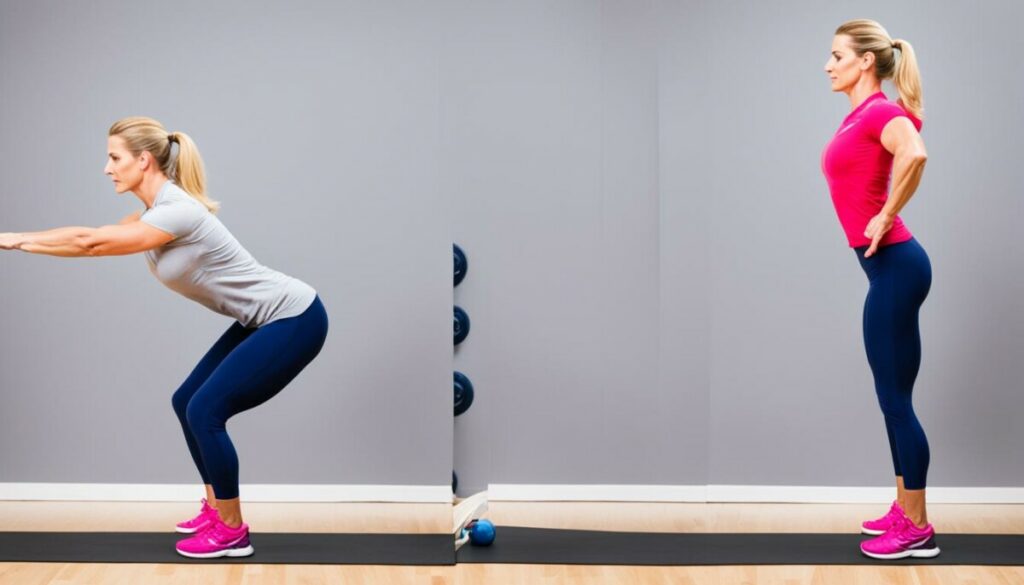Last Updated on 3 months by Francis
Looking to strengthen your lower body and improve overall fitness? Look no further than sisi squats. These powerful squat exercises target your quads like no other, giving you a challenging lower body workout that yields impressive results. Whether you’re a beginner or a seasoned fitness enthusiast, adding sisi squats to your strength training routine will take your fitness to the next level.
During sisi squats, you engage multiple muscles in your lower body, including your quads, hamstrings, and glutes. This makes it an excellent choice for an all-around fitness routine that works various muscle groups simultaneously. By incorporating these leg exercises into your routine, you’ll not only build strength but also improve balance, stability, and muscle definition.
Contents
Key Takeaways:
- Sisi squats are an effective lower body workout that targets the quads, hamstrings, and glutes.
- Proper squat form is crucial for maximizing the benefits of sisi squats.
- Incorporate sisi squats into your fitness routine to improve leg strength, balance, stability, and muscle definition.
- Avoid common mistakes such as not lowering yourself down slowly and rounding your shoulders forward.
- Consult with a fitness professional if you have any concerns or pre-existing conditions before incorporating sisi squats into your workout routine.
How to Perform the Sissy Squat

Proper squat form is essential to maximize the benefits of sisi squats and prevent injury. Follow these steps to perform the exercise correctly:
- Start by standing with your feet shoulder-width apart.
- Choose a hand position that is comfortable for you – behind your head, at your sides, or in front of you for balance.
- Slowly lower your body as far as you can while leaning your body backward. Aim to maintain a straight line from your head to your knees.
- As you descend, keep your weight on your heels and engage your core for stability.
- Squeeze your quads and push through your heels to raise yourself back to the starting position, maintaining control throughout the movement.
- Repeat the exercise for the desired number of reps, focusing on proper form and full range of motion.
Remember, good form is crucial for targeting the quads effectively and reducing the risk of injury. Take your time to master the proper technique before progressing to more advanced variations.
Common Sissy Squat Mistakes

When performing sisi squats, it’s important to avoid common mistakes that can hinder your progress. By focusing on proper form, you can ensure maximum engagement of your quads and avoid injury.
1. Not Lowering Yourself Down Slowly and Under Control
One common mistake when performing sisi squats is rushing through the movement and not controlling the lowering phase. It’s crucial to lower yourself down slowly and under control, focusing on the tension in your quads. This controlled descent allows for greater quad engagement and helps build strength effectively. Remember, quality over quantity.
2. Not Squeezing Your Quads and Driving Yourself Back Up with Force
Another mistake to avoid is neglecting to squeeze your quads at the top of the movement and not generating enough force to drive yourself back up. To optimize quad engagement, concentrate on forcefully contracting your quads at the peak of the exercise and driving yourself back up with power. This will enhance muscle activation and promote strength development.
3. Rounding Your Shoulders Forward
A common form error during sisi squats is rounding the shoulders forward instead of keeping them back and engaged. This not only puts unnecessary strain on your neck and upper back but also compromises the effectiveness of the exercise. Focus on maintaining a neutral spine position throughout the movement, keeping your shoulders back and chest lifted. This posture will help protect your spine and allow for optimal quad activation.
By being mindful of these common mistakes and prioritizing proper form, you can maximize the benefits of sisi squats and avoid potential pitfalls. Remember to perform the exercise in a controlled manner, emphasizing quad engagement and maintaining good posture throughout the movement.
Quote:
“Proper form is essential when performing sisi squats. By avoiding common mistakes and focusing on quad engagement, you can optimize your workout and achieve better results.”
Common Sissy Squat Mistakes
| Mistakes | Effects | Recommendation |
|---|---|---|
| Not lowering yourself down slowly and under control | Reduced quad engagement and limited strength development | Lower yourself down slowly and focus on quad tension |
| Not squeezing your quads and driving yourself back up with force | Insufficient quad activation and limited muscle growth | Squeeze your quads at the top and generate force during the upward movement |
| Rounding your shoulders forward | Increased strain on the neck and upper back, compromised exercise effectiveness | Maintain a neutral spine position with shoulders back and chest lifted |
Remember, avoiding these common mistakes and maintaining proper form will enable you to make the most out of your sisi squat workouts, leading to improved quad engagement, strength gains, and injury prevention.
Sissy Squat Sets and Reps
When incorporating sisi squats into your workout routine, determining the appropriate number of sets and reps is crucial for maximizing results. The ideal sets and reps for sissy squats depend on your experience level and fitness goals.
For beginners, it is recommended to start with 2-3 sets of no more than 5 reps. This initial focus on form and technique allows you to establish a solid foundation and avoid potential injuries. Take your time to understand and perfect the proper execution of the exercise before gradually increasing the intensity.
As you progress and become more comfortable with sisi squats, you can increase the number of sets and reps to challenge your muscles further. It is essential to listen to your body and avoid pushing beyond your limits, as maintaining proper form is key to achieving optimal results.
Remember, quality over quantity is paramount when performing sissy squats. Prioritize executing each repetition with precision, engaging your quads fully and ensuring controlled movements throughout the exercise.
By progressively adjusting your sets and reps and consistently practicing proper form, you can effectively develop your quad muscles and unlock the full potential of sisi squats in your workout routine.
Tips for Effective Sisi Squat Sets and Reps
- Start with 2-3 sets of no more than 5 reps as a beginner.
- Focus on form and technique to establish a strong foundation.
- Gradually increase sets and reps as you become more comfortable.
- Listen to your body and avoid pushing beyond your limits.
- Always prioritize maintaining proper form over quantity.
Recommendation for Intermediate and Advanced Levels
Once you have mastered the basics and built sufficient strength and stability, you can consider challenging yourself with higher sets and reps. Keep in mind that the number of sets and reps is not as important as proper execution and muscular engagement. Below is a suggested progression for intermediate and advanced fitness enthusiasts:
| Experience Level | Sets | Reps |
|---|---|---|
| Intermediate | 3-4 | 8-12 |
| Advanced | 4-5 | 12-15 |
Remember to always listen to your body, rest when needed, and consult with a fitness professional if you have any concerns or pre-existing conditions before incorporating sisi squats into your workout routine.
Sissy Squat Variations

Looking to add some spice to your sisi squat routine? Try incorporating these variations into your workout to target your quads and challenge your lower body like never before.
Banded Sissy Squat
Add resistance to your sissy squats by using a band. Loop the band around your knees or ankles, then perform the squat as usual. The band will provide continuous tension, making every rep more challenging and effective. This variation is perfect for those looking to increase quad activation and build strength.
Weighted Sissy Squat
Take your sissy squats to the next level by incorporating weights. Hold a dumbbell, kettlebell, or weighted plate close to your chest as you perform the squat. The added weight will intensify the exercise, helping you build muscle and strength in your quads. Remember to start with lighter weights and gradually increase as you become more comfortable and stronger.
Kneeling Sissy Squat
Want to engage both your quads and hamstrings? Try the kneeling sissy squat. Start by kneeling on a soft surface with your feet secured under a stable object. Lean your body backward and perform a sissy squat motion. This variation targets both the front and back of your thighs, providing a well-rounded lower body workout.
Muscles Worked By the Sissy Squat

The sissy squat exercise is an excellent way to engage and strengthen various muscle groups in your lower body. By understanding the specific muscles targeted during this exercise, you can maximize your workouts and achieve optimal results. Let’s take a closer look at the muscles worked by the sissy squat:
- Quads (Rectus Femoris): The sissy squat primarily targets the quadriceps, specifically the rectus femoris muscle. This is the largest muscle in the quadriceps group and is responsible for extending the knee and flexing the hip.
- Hip Flexors: In addition to the quads, the sissy squat also engages the hip flexor muscles. These muscles, including the iliopsoas and rectus femoris, are responsible for flexing the hip joint and lifting the thigh towards the chest.
- Core Muscles: Performing sissy squats requires stability and balance, which heavily involves the core muscles. The core muscles, including the abdominals, obliques, and lower back, work together to maintain proper posture and prevent excessive sway or lean during the exercise.
By regularly incorporating sissy squats into your fitness routine, you can effectively engage and strengthen these muscles, leading to improved lower body strength, muscle definition, and overall athleticism.
Benefits of the Sissy Squat
The sissy squat offers numerous benefits for individuals looking to enhance their lower body workouts. Incorporating sisi squats into your fitness routine can lead to:
- Leg Toning: Sisi squats target the leg muscles, including the quads, hamstrings, and glutes, helping to tone and strengthen them.
- Improved Balance: By engaging the core and stabilizer muscles, sissy squats can improve balance and overall stability.
- Muscle Definition: Regularly performing sisi squats can contribute to muscle definition, particularly in the legs.
Furthermore, sisi squats help increase flexibility, especially in the hip flexors, while also providing a challenging lower body workout. As a compound exercise, the sissy squat engages multiple muscle groups simultaneously, maximizing efficiency and promoting overall lower body strength.
By incorporating sisi squats into your fitness routine, you can achieve stronger, more toned legs, improved balance, and enhanced muscle definition. Whether you’re looking to build lower body strength or simply add variety to your workouts, sissy squats are an excellent exercise to consider.
Who Should Do the Sissy Squat?
While sissy squats are generally suitable for most bodybuilders and fitness enthusiasts, it is important to consider certain factors before incorporating this exercise into your routine. Individuals with knee problems, backaches, or herniated discs should exercise caution or avoid this exercise altogether.
It is essential to listen to your body and prioritize your safety. If you have any pre-existing conditions or concerns, consulting with a healthcare professional or a qualified fitness trainer is highly recommended. They can assess your suitability for sissy squats and provide guidance on alternative exercises that can target the same muscle groups without risking further injury or discomfort.
| Who Should Do the Sissy Squat? | Who Should Avoid the Sissy Squat? |
|---|---|
|
|
It’s crucial to remember that everyone’s body is different, and what works for one person may not work for another. Your safety and well-being should always come first. By seeking professional advice and being aware of your limitations, you can make informed decisions about incorporating sissy squats or alternative exercises into your fitness routine.
Conclusion
Incorporating sisi squats into your workout routine is a smart choice for anyone looking to strengthen their lower body and develop defined muscles. By paying attention to proper form and technique, you can maximize the benefits of this exercise and see significant improvements in your leg strength and muscle tone.
Remember, consistency is key. Start with a few sets of sisi squats and gradually increase the intensity as you become more comfortable. However, always prioritize maintaining proper form over quantity. This will ensure that you engage the right muscles and avoid injury.
Before starting any new exercise program, it’s important to consult with a fitness professional. They can help assess your fitness level, monitor your progress, and offer guidance specific to your needs and goals. Additionally, if you have any pre-existing conditions or concerns, it’s crucial to seek medical advice to ensure sisi squats are suitable for you.
By incorporating sisi squats into your lower body workout routine, you can experience the fitness benefits of stronger legs, increased muscle development, and enhanced overall fitness. So, lace-up your sneakers and get ready to work those quads with sisi squats!
FAQ
What are sisi squats?
Sisi squats are a type of squat exercise that targets the quads and can be performed using just your body weight.
How do I perform sisi squats properly?
To perform sisi squats, stand with your feet shoulder-width apart, lower your body while leaning backward, and squeeze your quads as you raise yourself back up.
What mistakes should I avoid when doing sisi squats?
Common mistakes to avoid include not lowering yourself down slowly, not squeezing your quads, and rounding your shoulders forward.
How many sets and reps should I do for sisi squats?
The number of sets and reps depends on your experience level, but beginners are recommended to start with 2-3 sets of up to 5 reps.
Are there variations of the sissy squat?
Yes, variations include the banded sissy squat, weighted sissy squat, and kneeling sissy squat.
What muscles do sisi squats work?
Sisi squats primarily target the quads, hip flexors, and core muscles for stability and balance.
What are the benefits of doing sisi squats?
Benefits include toning and strengthening the legs, improving balance and coordination, increasing flexibility, and promoting muscle definition.
Who should do sisi squats?
Sisi squats are generally suitable for most bodybuilders and fitness enthusiasts, but individuals with knee problems, backaches, or herniated discs should exercise caution or avoid this exercise.
What are the overall fitness benefits of sisi squats?
Incorporating sisi squats into your workout routine can lead to stronger, more toned legs and improved overall fitness.









